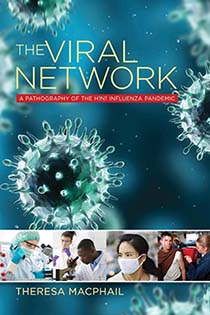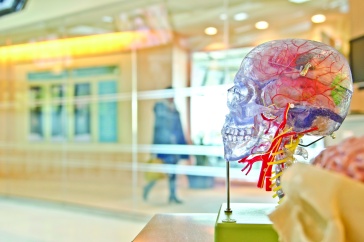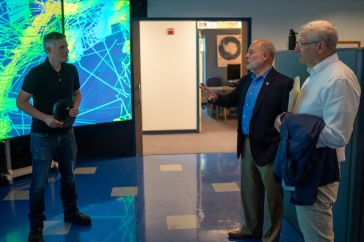
For the past decade, I’ve immersed myself in the complex world of influenza viruses, following the trails of H1N1, H5N1 and H7N9 around the globe. I’ve wandered crowded, stiflingly hot “wet” markets in China that sell live birds, fish and reptiles. I’ve volunteered to work alongside and observe global health analysts—the people whose job it is to spot a disease outbreak before it becomes a bigger problem—at the U.S. Centers for Disease Control in Atlanta.
I’ve trekked out to a decaying abandoned abattoir in Cheung Sha Wan, Kowloon, where thousands of pigs and cattle were slaughtered until the late 1990s, when a rash of bird flu outbreaks made the idea of housing and killing live animals in the city less palatable. I’ve observed virologists inside a lab that sequences viral RNA, doing influenza surveillance in the hopes of better understanding how and when the next deadly strain might emerge.
As a medical anthropologist, I study the social, economic and political culture of public health. Specifically, I research the experts who study viruses and who are called upon to combat them during pandemics. I think about how they know what they know. I ask questions about how they sort through a daily barrage of data in order to make urgent decisions that affect our health and safety.
My quest to understand how experts in public health do their jobs has taken me to places I would never have imagined visiting. I’ve found myself taking uncomfortable risks when they’ve felt essential for doing my job well. Sometimes—like when I’m defying everyone’s admonitions to steer clear of wet markets—it strikes me that these are exactly the types of situations my mother spent her life trying to protect me from.
Compared to what my mom thought could happen to me every day of my childhood, being inside a Biosafety Level 3 lab seems as safe as going for a stroll in my community park.
When I was 4 years old, my much older brother and his young family died at a rest stop, asphyxiated in an idling car with the one-in-a million combination of overlapping holes in the exhaust pipe and in the bed of their station wagon. My brother’s death turned my mother into a security guard whose sole purpose on earth was to protect her only remaining child.
Throughout my formative years, the world I lived in was a scary place, one where my mother expected terrible things to happen and taught me to do the same. I lived a very small life back then. My entire world consisted of my school, my house and my yard; if I went anywhere else, I had to be escorted. Over time, I learned to cope with the strictures my mom put on my movements; I accepted my limited options for “having fun.”
And then, when I was 14, my mom died in a car accident. Suddenly it seemed she’d been right: Horrible things really were waiting just around the corner, hidden from our view. But at my mother’s funeral, as I was staring down at her folded hands and thinking about how often they had held my own, I realized that they had also held me back.
I knew I had a decision to make. I could continue to live a small life and be fearful of the unknown. Or I could choose a larger life, one where I turned those corners and explored new avenues even if that meant coming into harm’s way. As I timidly began to practice being brave, I slowly expanded my tiny universe.
My father, however, was as fearful about my safety as my mother had been. Throughout high school, I couldn’t go out with friends more than once a week, had to be home by 9 p.m., and could never date. Then, the year after I graduated from UNH, my father died from a bee sting (coincidentally, he was in his car at the time). At 24, I had experienced more loss than most people double my age. But I was determined to stick to the promise I’d made myself at 14: I would not let fear dictate my choices.
If there is a thread that ties together all the things I’ve done in my life, it’s facing my fears. Whenever an opportunity arises to do something that makes me nervous and would have driven my parents to distraction, I grab it. I am comfortable being uncomfortable.

My graduate adviser once warned me that a good anthropologist will eventually be uncomfortable everywhere. That’s part of the job. Anthropologists constantly question what we are seeing in order to say something larger about what it means to be human. And you can’t do that well if you’re too close to your subject. We are trained to look at things as outsiders, to rethink all our assumptions about the world so that we can inch a bit closer to describing how it really feels to live, work, eat, pray, dance or love in the moment.
I’m also a trained writer. Experienced writers often advise beginning writers to tackle things that trouble them. A famous writer once counseled me to study and write about all the things I hated or feared until I finally understood them enough to stop hating or fearing them. That’s why I started to study viruses.
Living in Hong Kong in 2003, right after SARS, I was terrified of this new disease—and I wanted to understand why. It wasn’t all that probable that I would catch it, just as it’s not at all likely in 2015 that anyone will contract Ebola in the U.S. But statistics never seem to stop us from worrying.
The result of asking “Why are we so scared of influenza?” is the subject of my first academic book, The Viral Network: A Pathography of the H1N1 Influenza Pandemic. The incredibly abridged answer is that we fear what we’ve been trained to fear. Our history and culture shape our fears as much as any virus does.
In essence, I’ve been seeking answers to the question “why” for almost two decades. It began with a need to understand why all my closest relatives had died, then turned into a series of educational and career choices that helped me begin to study fear in all its guises. Today, as a medical anthropologist, I think of it this way: Asking why can be a powerful antidote to the viral contagion of fear.
Though I’ve become adept at facing my fears, the truth is, I’m still scared of almost everything. I’m terrified of getting cancer or dying in a car accident. I’m afraid of losing my job or getting mugged. But despite being one of the most fearful people I know, I have consciously chosen to lead an out-of-the-ordinary life. I’ve lived in China, studying the Chinese language. I’ve changed careers at least three times. I’ve been married twice. I practice being courageous, and I’d like to think I’m slowly getting better at it.
Right now I’m getting ready to go back into the field at the CDC in Atlanta and other international locations to study the disease surveillance systems that help to keep us safe. Last year’s lab breaches at the CDC involving anthrax and bird flu samples, as well as the forgotten vials of live smallpox viruses discovered at the NIH, remind me that the places I go are not risk-free. But I take risks, large and small, all the time. For instance, I’m working up the courage to sign up for an improv class because I’m always nervous being in front of people—something I have to do daily.
Now that I’m a professor, I often tell my students that the trick to a fulfilling life is simple: Learn to recognize your fears. Fear often disguises itself as something else —anger or dislike or derision. Fear can be as tricky as a virus, and just as contagious. It can infect you without your being fully aware of it. It can change the makeup of your personality and, if you let it, end up shaping the contours of your world.
My life is one long lesson in the art of facing fear. Here’s the best advice I’ve discovered so far: Every now and then, do something that scares you. Venture outside your comfort zone and challenge yourself. You’ll learn what you’re capable of, and that’s often much more than you think.
Ask more questions. In each conversation, ask someone about what she loves doing, what he has always secretly wanted to try, why she chose her profession. Other people’s passions are not only fascinating, but they can inspire you to find your own. Finally, be more interested in the world. Travel as much as you can, even if that means just exploring a new part of Vermont. Read voraciously about new cultures or people or places. Never stop learning.
I’m not just preaching all these things; I’m trying to practice them continuously. Last summer I started learning German and writing a science fiction novel. Writing fiction—now there’s something that really terrifies me. Researching physics and astronomy. Creating believable, sympathetic characters. Crafting a plot out of thin air. As I sit down to write, it all feels impossible.
But when I get stuck and tempted to quit, I’ll be reminding myself: Learning new things and taking small risks are like building up your immune system. If fear is a virus, the best anti-viral is exploration.~
Read more in a Q & A with Theresa MacPhail '94.

Though college students tend to imagine their professors aiming for academia from birth, that's rarely the case, and Theresa MacPhail’s route took more turns than most. She began as a journalist and model, then started grad school at age 29 never having heard of medical anthropology.
Ten years after entering NYU’s Draper interdisciplinary master’s program as a student, she returned to it as a professor, with a Ph.D. in medical anthropology from Berkeley. Even that, however, was not “the unicorn,” the elusive tenure-track faculty position. Now she has it. In September she began as an assistant professor of science and technology studies at Stevens Institute of Technology in Hoboken, N.J.
Her book The Viral Network: A Pathography of the H1N1 Influenza Pandemic was published in December 2014 by Cornell University Press. MacPhail also writes a writing-advice column for Vitae, the career site run by The Chronicle of Higher Education.
MacPhail, who lives in New York, spoke with Jane Harrigan (with whom she took a journalism course in the 1990s) while on vacation in New Hampshire. Their conversation touched not just on perseverance and overcoming fear, but on the power of writing and the chance academic encounters that can change the course of a student’s life.
Originally published in UNH Magazine—Winter 2015 Issue
-
Written By:
Theresa MacPhail '94 | Communications and Public Affairs
















































